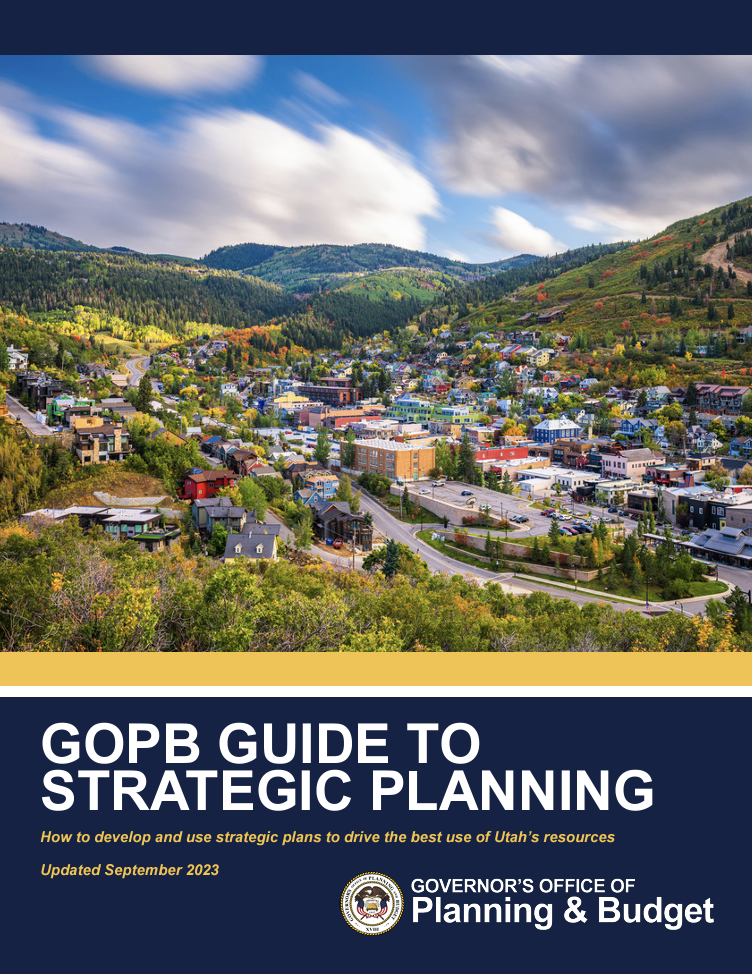The Cox-Henderson administration prioritizes strategic planning and improving agency strategic plans to drive effective investments and best use of Utah’s resources. These plans should include efforts to improve efficiency, productivity, and customer service. Strategic planning benefits each agency as it promotes effective work, facilitates performance management, and improves strategic budgeting.
PRIORITIZING STRATEGIC PLANNING
In 2022, GOPB initiated a focus on strategic planning, including creating an inventory of agency strategic plans, producing the The GOPB Guide to Strategic Planning, and holding information sessions to help agencies with the strategic planning process.
By the FY 2025 budget cycle, all agencies are required to maintain strategic plans which will guide performance measure development and drive budget development. Future plans should also include opportunity goals; more direction will be given for plan updates later.
STRATEGIC PLANNING RESOURCES
The GOPB Guide to Strategic Planning is the primary resource for agency strategic planning. It establishes philosophy, structure, and best practices for strategic planning, details a step-by-step process overview for agencies to create their own strategic plans, and helps agencies align priorities for statewide coordination.
GOPB has conducted four information sessions on strategic planning that answer some common questions and contain links to examples and state resources.
The GOPB Planning team is available to help with the planning process, answer questions, and review draft plans. Contact Terrah Anderson to arrange for help or ask questions. Agencies should also inform their assigned budget analyst about the progress of their strategic plans.
AGENCY ROLE IN STRATEGIC PLANNING
Strategic plans are meant to be used. Agency strategic planning teams should create a plan that has meaningful goals, furthers the innovative and efficient work of the agency, and will be reviewed frequently.
A typical strategic plan includes the elements outlined below. Many, if not all, of these elements should be included in each agency strategic plan. However, agency leaders have the flexibility to create a plan that best suits their needs. Performance measures and anticipated budget requests are required elements of each strategic plan.

RECOMMENDED AGENCY TIMELINE
Agency strategic planning is ongoing and cyclical in nature. Strategic plans should be reviewed annually and should include updates to strategies and work plans. Strategic plans should be significantly refreshed every four to eight years. Similar processes can be used for creating and updating agency strategic plans.
After strategic plans are created or updated, they should be used regularly. The strategic plan should be referenced in staff meetings, used to make strategic decisions, and guide agency work. Employees should use the plan to monitor progress towards goals and update the annual work plan.
GOPB’s goal is to support agency leaders in creating meaningful strategic plans that inform the budget process. GOPB provides training sessions, resource materials, and help to agencies throughout the strategic planning process. Ultimately, the key decisions about creating and implementing plans are up to each agency.
GOPB recommends the following timeline for strategic plan development, utilization, and review:

July: Final Plan
- Share the plan with employees and stakeholders.
- Share the plan with GOPB for the statewide agency strategic plan inventory.
- Publish on agency website.
- GOPB uses the strategic plan to inform the FY 2026 budget process.
- GOPB creates an inventory of strategic plans for internal and external reference.
Aug-Dec: Use Strategic Plan
- Use the strategic plan. Reference it in staff meetings, use it to make strategic decisions and guide agency work, monitor progress and update the annual work plan.
- GOPB provides training sessions, resource materials, and help to agencies throughout the strategic planning process.
Jan: Review Plan
- Consider any desired strategic plan updates. Strategic plans should be reviewed annually and review should include updates to strategies and work plans. Strategic plans should be significantly refreshed every four to eight years.
Feb: Organize and Inform
- Discuss timeline and process.
- Select strategic planning team members.
- Plan and execute a kickoff meeting/retreat, if needed, to address significant changes.
- Review current plans and materials.
Mar-Apr: Analyze and Prioritize
- Discuss critical questions (see guidebook).
- Evaluate what information is needed and from whom, and the methods of collection to be used.
- Gather information from employees, stakeholders, customers, and the public.
- Assess performance, external opportunities and challenges, internal strengths and weaknesses.
- Analyze and compile feedback.
- Determine major findings and areas of focus for the strategic plan.
May-Jun: Write and Evaluate Draft Strategic Plan
- Choose a format for the plan, create the outline.
- Finalize details, write the plan.
- Determines timing and implementation of each strategy.
- Gather input on the draft plan from GOPB, employees, and stakeholders.
- Set processes for the plan to be regularly reviewed and used.
FOR MORE INFORMATION PLEASE CONTACT:
GOPB Planning
Opportunity
Performance Measures
